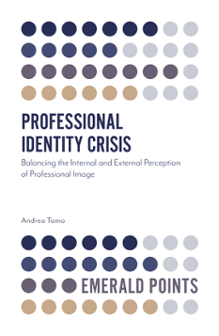
Index
Andrea Tomo
(University of Naples Federico II, Italy)
ISBN: 978-1-78769-808-6, eISBN: 978-1-78769-805-5
Publication date: 8 July 2019
This content is currently only available as a PDF
Citation
Tomo, A. (2019), "Index", Professional Identity Crisis, Emerald Publishing Limited, Leeds, pp. 149-152. https://doi.org/10.1108/978-1-78769-805-520191002
Publisher
:Emerald Publishing Limited
Copyright © 2019 Emerald Publishing Limited
INDEX
Accounting profession
, 8–9, 103–107, 121–122
identity struggles
, 41–43
Architecture, engineering, and design
identity struggles
, 43–44
Arts and culture
identity struggles
, 44, 45
Auditing profession
, 8–9
identity struggles
, 41–43
Behavioural perspective
, 2, 5
in coping with hardships
, 100–103
Certification systems
, 78
Chartered accountants
, 99–100
Collaboration
, 65
Commercialism
, 8–9, 39, 43–44
Commercial logics
, 42, 54–55
Complex phenomenon, professional identity as
, 2
Coping with hardships, behavioural perspective in
, 100–103
Country analysis
, 21
Creativity
, 39, 40–41, 43–44
Crisis of professional identity
, 60–66
Deontology
, 62–63
De-professionalization
, 3–4, 59–60, 66–74, 119, 121–122
professionals’ attempts to manage. See Professionals’ attempts to manage uncertainties and de-professionalization
Deskilling
, 71
Duplicate elimination
, 18–19
Economic volatility
, 3, 97, 120
External image, perception of
, 106
Flexibility-oriented approach
, 74–92
individuals, role of
, 81–85
institutions and organizations, role of
, 85–88
vision of
, 88–92
Framing questions
, 18
Generic reference to PSFs
identity struggles
, 45
Gig economy
, 97
Globalization
, 77–78, 89–90
Goal orientation
, 101–102, 107, 108–109, 110–112
perceived external image and
, 102–103, 121–122
Google Scholar
, 18
Healthcare
identity struggles
, 42–43
Identity construction
, 12, 101–102
Identity crisis
, 3, 18, 118–119, 124
in Italian educational and training sectors
, 67–70
Identity narrative
, 118
Identity practices
, 63
Identity struggles
, 13, 14, 18
antecedents of
, 19–45
categorization
, 39, 40
categorization of
, 39, 40
consequences of
, 19–45
categorization
, 40–41
multi-level approach to
, 46–55, 47–52
per type of profession
, 41–45
Identity threats
, 40–41, 117, 118
Impression management
, 42, 43–44, 117, 118
Inclusion criteria
, 18–19
Instability
, 115
Institutional approach
, 14–15
Institutional gaze
, 85–87, 89
Institutional practices
, 64
Integration
, 15, 116
ISI Web of Knowledge database
, 18
Italian educational and training sectors, identity crisis in
, 67–70
Job crafting
, 42, 43–44, 45, 55, 118
Job insecurity
, 40, 115, 120
Knowledge accumulation
, 80
Knowledge construction
, 80
Learning goal orientation
, 101–102
Macro-role transitions
, 12–13
Management consulting
identity struggles
, 45
Managerialism
, 39
Marketing and PR
identity struggles
, 45
Micro-role transitions
, 12–13
Multi-level approach
, 11, 16–17, 18–19
to identity struggle
, 46–55, 47–52
Negotiation
, 61–63
Organizational behaviour
, 5
Organizational change
, 116
Organizational demands
, 45, 53–55
Organizational expectations
, 45
Organizational identity
, 11, 13, 101
Organizational practices
, 63
Organization studies
, 5
Perceived external image, and goal orientation
, 102–103, 121–122
Performance goal orientation
, 101–102
Precariousness
, 59–60, 66–74, 86–87
Precarization
, 3, 95, 119
Previous literature on professional identity
, 10–17
Proactive behaviour
, 116, 117
Proactive personality
, 99, 100, 103, 106–107, 108–111, 121–122
Professional autonomy
, 117–118
Professional crisis
, 18
Professional group
, 64, 67, 118–119
Professional identity
, 18
Professionalism
, 8–9, 39, 69–70, 72, 93, 119–120
Professional prestige
, 40
Professionals’ attempts to manage uncertainties and de-professionalization
, 95
behavioural perspective in coping with hardships
, 100–103
case study
, 103–107
data and procedures
, 105, 106
measures
, 105–107
research context
, 103–104
findings and discussion
, 107–111
future research agenda
, 113
theoretical and practical implications
, 111–113
Proletarianization
, 3, 59–60, 66–74, 95, 119
Proliferation of regulations
, 78
Quality of studies, assessment of
, 18–19
Research design
, 17–19
Resistance
, 16
Risk exposure
, 82–83
Role ambiguity
, 11
Role attribution
, 54–55
Role clarity
, 43
Role integration
, 12–13
Role segmentation
, 12–13
Role tension
, 13, 14, 15
Savoir bricoleur
, 88–89, 90–91
Segmentation
, 15, 116
Self-affirmation
, 64
Self-efficacy
, 99
Self-employment
, 72
Self-image
, 99
Sensemaking
, 118
Single-level analysis
, 11
Social identity theory
, 12
Study analysis
, 20
Summarizing results
, 19, 22–38
Sustainability
, 88
SWOT analysis
, 61
Technological change
, 3, 97, 120
Technology, role of
, 75–77
Threatened identity
, 13, 14, 18
Threatened professionals
, 18
Turnover intention
, 40, 41–42, 45, 46
Uncertainties
, 80, 91
professionals’ attempts to manage. See Professionals’ attempts to manage uncertainties and de-professionalization
Work identity
, 83, 84, 90–91, 92